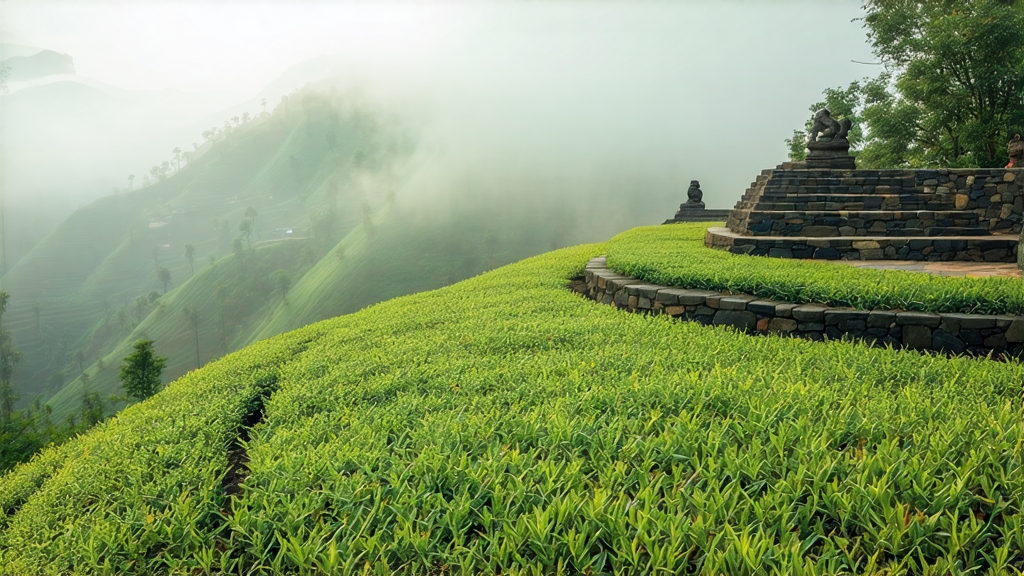
Tucked high on the mist-veiled shoulders of Mount Meng in Sichuan Province, Meng Ding Huang Ya—literally “Yellow Bud from the Summit of Meng”—is the quiet aristocrat of Chinese tea. While green teas steal export statistics and dark pu-erhs fill auction headlines, this yellow tea has survived dynastic collapses, wartime neglect, and market indifference to remain the drink Chinese emperors once called “the dew of heaven.” To understand it is to witness a six-hour window of spring, a guarded technique known only to a handful of families, and a flavor that suspends time somewhere between fresh orchid and warm chestnut.
Historical whispers
The first written record appears in a Tang-dynasty gazetteer from 808 CE, describing “a pale-gold liquor sent in bamboo tubes to Chang’an.” By the Song, Meng Ding’s buds were measured by the grain—eight thousand tips to make one jin—then sealed with wax and escorted by horseback to the palace. When the Ming court shifted its taste to loose-leaf greens, yellow tea retreated into monasteries, where monks prized its gentle stomach-soothing warmth during prolonged meditation. Only in 1959 did the state re-launch Meng Ding Huang Ya as a national gift tea, yet even today annual production rarely exceeds three metric tons, most of it pre-sold to collectors in Chengdu and Taipei.
Micro-climate and terroir
Mount Meng rises abruptly from the Sichuan basin to 1 456 m, trapping perennial cloud at the 800–1 200 m belt where the tea gardens cling to narrow terraces of purple sandstone. Year-round humidity hovers at 85 %, diffusing sunlight into a soft silver that forces the bushes—local small-leaf seed-grown stock known as chuancha—to produce extra theanine. Night temperatures can drop 10 °C within an hour, locking floral aromatics inside the bud while discouraging coarse fiber growth. The result is a needle so tender it can be kneaded between two fingers without breaking, yet so fragrant it perfumes an entire room before water even touches it.
Plucking code
The harvest calendar is ruthless: only three mornings, usually between 20 March and 5 April, when the standard is “one bud just unfolded, no leaf, no rain, no purple.” Experienced pickers work with thumbnail length calibrated since childhood; a snap too low includes the lignifying stem, too high leaves the energy store behind. Each kilo of finished tea demands roughly 72 000 buds, all carried down the slope in bamboo baskets lined with fresh banana leaf to prevent compression bruises.
The secret of sealed yellowing
What converts an otherwise green tea into yellow is the enigmatic men huang—“sealed yellowing.” After a 30-second high-heat shaqing (kill-green) at 160 °C on a cast-iron wok, the buds are piled 4 cm deep inside linen bags and left in a humid 28 °C room for 70–90 minutes. During this interval chlorophyll quietly oxidizes without enzymatic help, catechins polymerize into softer theaflavins, and a hint of methyl salicylate emerges, gifting the tea its signature orchid-chestnut bouquet. The master judges readiness by aroma alone: when the wet-grass note vanishes and a sweet corn-milk scent surfaces, the buds are quickly re-fired at 80 °C, rolled for 8 minutes under 0.8 kg pressure, then dried in three descending temperature stages ending at 50 °C. Over-yellowing produces dull hay; under-yellowing keeps the leaf green and the liquor astringent. Only two families on the mountain still possess the generational nose for this moment.
Leaf appearance and grading
Supreme grade (Te Ji) shows uniform 1.5 cm needles, golden downy tips visible under oblique light, and a faint olive-green vein that flashes yellow when flexed. First grade keeps the same length but tolerates 5 % open leaves; second grade allows slight curvature and 10 % two-leaf sets. Anything longer is diverted into the local green-tea market, ensuring Meng Ding Huang Ya remains the shortest, slenderest, and most down-covered of all yellow teas.
Water philosophy
The classic Sichuan saying goes, “Meng Ding three boils: first for the gods, second for the guest, third for the soul.” Use spring water low in minerals, 80 °C for the first infusion, 85 °C for the second, and 90 °C for the third. A tall, thin